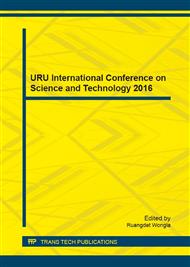[1]
F.P. Gasparro, M. Mitchnick, J.F. Nash, A review of sunscreen safety and efficacy, Photochem. Photobiol. 68 (1998) 243–256.
DOI: 10.1111/j.1751-1097.1998.tb09677.x
Google Scholar
[2]
L.H. Kligman, F.J. Akin, A.M. Kligman, The contributions of UVA and UVB to connective tissue damage in hairless mice, J. Invest. Dermatol. 84 (1985) 272–276.
DOI: 10.1111/1523-1747.ep12265353
Google Scholar
[3]
J. Marto, L.F. Gouveia, B.G. Chiari, A. Paiva, V. Isaac, P. Pinto, P. Simões, A.J. Almeida, H.M. Ribeiro, The green generation of sunscreens: Using coffee industrial sub-products, Industrial Crops and Products 80 (2016) 93–100.
DOI: 10.1016/j.indcrop.2015.11.033
Google Scholar
[4]
R.M. Amin, S.A. Elfeky, T. Verwanger, B. Krammer, A new biocompatible nanocomposite as a promising constituent of sunscreens, Materials Science and Engineering C 63 (2016) 46–51.
DOI: 10.1016/j.msec.2016.02.044
Google Scholar
[5]
W-Y. Hsiao, S-J. Jiang, C-H. Feng, S-W. Wang, Y-L. Chen, Determining ultraviolet absorbents in sunscreen products by combining direct injection with micelle collapse on-line preconcentration capillary electrophoresis, J. Chromatogr. A 1383 (2015).
DOI: 10.1016/j.chroma.2015.01.039
Google Scholar
[6]
A. Morlando, D. Cardillo, T. Devers, K. Konstantinov, Titanium doped tin dioxide as potential UV filter with low photocatalytic activity for sunscreen products, Materials Letters 171 (2016) 289–292.
DOI: 10.1016/j.matlet.2016.02.094
Google Scholar
[7]
D.R. Sambandan, D. Ratner, Sunscreens: An overview and update, J AM ACAD DERMATOL, 64 (2011) 748-758.
Google Scholar
[8]
Camile L. Hexsel, Scott D. Bangert, Adelaide A. Hebert, Henry W. Lim, Current sunscreen issues: 2007 Food and Drug Administration sunscreen labelling recommendations and combination sunscreen/insect repellent products, J AM ACAD DERMATOL, 59 (2008).
DOI: 10.1016/j.jaad.2008.03.038
Google Scholar
[9]
A. Beeby, A.E. Jones, Photophysical properties of N-acetyl-menthyl anthranilate, Photochem. Photobiol., 64 (2001) 109–116.
DOI: 10.1016/s1011-1344(01)00197-x
Google Scholar
[10]
T. Karthick, V. Balachandran, S. Perumal, A. Nataraj, Spectroscopic studies, HOMO-LUMO and NBO calculations on monomer and dimer conformer of 5-nitrosalicylic acid, J. Mol. Struct, 1005 (2011) 192-201.
DOI: 10.1016/j.molstruc.2011.08.050
Google Scholar
[11]
B.A.M. Corrêa, A.S. Gonçalves, A.M.T. de Souza, C.A. Freitas, L.M. Cabral. M.G. Albuquerque, H.C. Castro, E.P. dos Santos, C.R. Rodrigues, Molecular modeling studies of the structural, electronic, and UV absorption properties of benzophenone derivatives, J. Phys. Chem. A, 116 (2012).
DOI: 10.1021/jp306130y
Google Scholar
[12]
Gaussian 09, Revision D. 01, M. J. Frisch, G. W. Trucks, H. B. Schlegel, G. E. Scuseria, M. A. Robb, J. R. Cheeseman, G. Scalmani, V. Barone, B. Mennucci, G. A. Petersson, H. Nakatsuji, M. Caricato, X. Li, H. P. Hratchian, A. F. Izmaylov, J. Bloino, G. Zheng, J. L. Sonnenberg, M. Hada, M. Ehara, K. Toyota, R. Fukuda, J. Hasegawa, M. Ishida, T. Nakajima, Y. Honda, O. Kitao, H. Nakai, T. Vreven, J. A. Montgomery, Jr., J. E. Peralta, F. Ogliaro, M. Bearpark, J. J. Heyd, E. Brothers, K. N. Kudin, V. N. Staroverov, R. Kobayashi, J. Normand, K. Raghavachari, A. Rendell, J. C. Burant, S. S. Iyengar, J. Tomasi, M. Cossi, N. Rega, J. M. Millam, M. Klene, J. E. Knox, J. B. Cross, V. Bakken, C. Adamo, J. Jaramillo, R. Gomperts, R. E. Stratmann, O. Yazyev, A. J. Austin, R. Cammi, C. Pomelli, J. W. Ochterski, R. L. Martin, K. Morokuma, V. G. Zakrzewski, G. A. Voth, P. Salvador, J. J. Dannenberg, S. Dapprich, A. D. Daniels, Ö. Farkas, J. B. Foresman, J. V. Ortiz, J. Cioslowski, and D. J. Fox, Gaussian, Inc., Wallingford CT, (2009).
Google Scholar
[13]
A.R. ALLOUCHE, Gabedit - A graphical user interface for computational chemistry softwares, Journal of Computational Chemistry, 32 (2011) 174-182.
DOI: 10.1002/jcc.21600
Google Scholar


